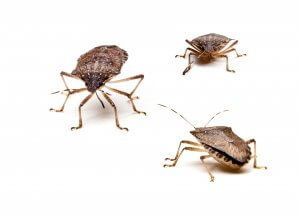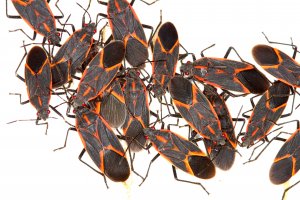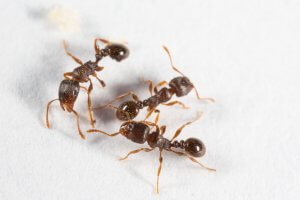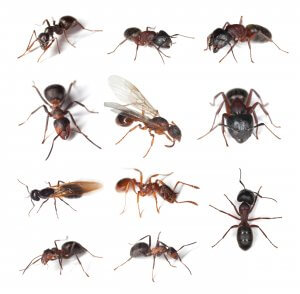As shadows lengthen and days become shorter, we begin to see some six-legged critters sneaking around our windows, eaves, and soffits. This change is a good time for a reminder about just who some of these fall invaders are and how you can tell them apart. The insects are all just following the instinct to seek a secluded overwintering spot. Unfortunately for everyone, what happens next is anything but natural. The exterior sidewalls of our structures provide a beautiful array of nooks and crannies for these critters to sneak. The problem is that these spaces are often within human dwellings.
Who are the fall invaders on the side of my home?
Three of Michigan’s fall invaders are closely related in the order Hemiptera, or ‘true bugs.’ They are the boxelder bug, brown marmorated stink bug (BMSB), and western conifer seed bug (Table 1). During late summer and fall, it is possible to find all three species on one building.
Of these three insects, the brown marmorated stink bug is the newest arrival to Michigan, and the only one is a garden or agricultural pest. Often mistaken as a BMSB, western conifer seed bug is less common and mostly remains unnoticed until fall. Boxelder bugs are native Michigan insects that can be relatively abundant in some parts of the state. Boxelder bugs are not considered garden pests, but they can become a nuisance in homes only due to the large quantities that can accumulate on around doors, windows, and in attics over the winter.
If you are unsure whether the insects in your home are BMSB or not, Table 1 will help tell them apart. We use the shape of their hind legs, overall body shape, and color to differentiate these three fall invaders.
Table 1. Features that distinguish Michigan’s most common true bugs (Hemiptera) |
||||
|---|---|---|---|---|
| Common name | Diet | Body | Hind legs | Color |
| Brown marmorated stink bug | Wide variety | Pentagonal | Long & thin | Brown, tan, with white |
| Western conifer seed bug | Seeds of conifers | Elliptical | Flat & broadened | Brown, tan, with white |
| Boxelder bug | Boxelder and related maples | Elliptical | Long & thin | Black with red |
Like many insects in the order Hemiptera, all three have a piercing-sucking mouthpart and can use it in self-defense. In other words, handle them with caution. It is important to note, however, that none of these insects sting or transmit disease; they do not reproduce in the winter. They are simply nuisance pests. In some of the most severe cases, excretions from high numbers of these bugs may stain furniture.
A fourth fall invader worth mentioning is the Asian lady beetle. These beetles spend their summers dining on aphids and other agricultural pests. They form large aggregations on the sides of structures in the fall as they search for a spot to overwinter.
Unlike the three mentioned previously, multi-colored Asian lady beetles are beetles (Coleoptera), not true bugs. Asian lady beetles can bite but do not spread disease. They also emit foul-smelling defensive secretions that can stain fabrics, and, in rare cases, can cause allergic reactions.
What causes these fall invaders to gather?
The summer months are when insects are active outdoors. However, as daylight lessens, insects undergo a physiological change known as ‘diapause.’ diapause is a time of inactivity during which they eat little to nothing and do not reproduce. In their natural habitats, the insects spend winter beneath tree bark.
BMSB begin to gather on the SW-W sides of buildings when there is less than 12.5 hours of daylight, usually the second or third week of September in Michigan. They mainly migrate toward garages, sheds, and siding with small spaces or gaps that protect them from the elements. For several weeks in the fall, BMSB and other aggregating insects may attempt to enter homes searching for an environment protected from snow and cold temperatures.
How can I keep them out?
In fall, be sure to check for gaps on the outside of the house that are wide enough for insects to enter. You can cover these areas with screens, wire mesh, or caulk. Window air conditioners should be checked for gaps. When hundreds of swarming insects are outside of a home, leave the windows closed or check for openings in the screen. The force of water from a hose knocks insects off exterior walls.
On homes with severe outbreaks, we apply a pest control treatment to the foundation or siding.
What do I do once they are inside?
The best way to control nuisance pests indoors is through removal or exclusion by a professional. Inside, BMSB are attracted to light and may fly towards light fixtures, resulting in an annoying buzz. We do not recommend applying insecticides to overwintering insects that are already inside your home. The chemicals will only kill insects that make direct contact and prevent additional insects from finding their way inside.
When hundreds of stink bugs are in the home or shed, vacuum with a shop-vac, on warmer winter days, a stray stink bug or two may emerge from diapause and walk or fly around the house. By this time, all overwintered insects are already inside a home, and hand-picking is the easiest way to eliminate them.
Fall invaders perpetually return each year. However, knowing the signs and how to prevent an invasion from occurring in your home is imperative.



